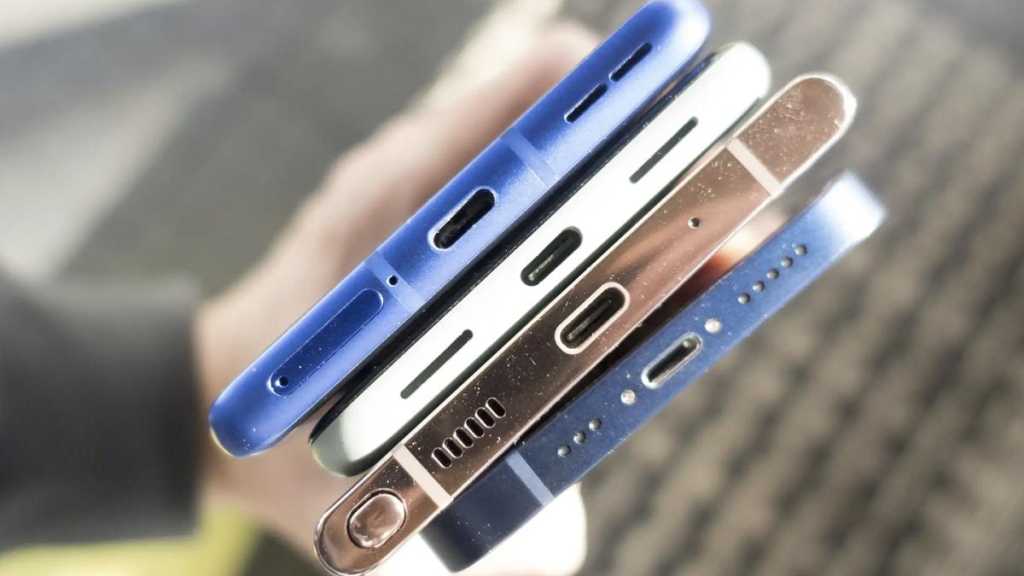We’ve known that the iPhone is switching to USB-C for a while now, but there was always a possibility that Apple would stick with Lightning for one more year. Based on the latest leaked images, however, Apple is all-in on USB-C for the iPhone 15 and iPhone 15 Pro models, with USB-C parts for the iPhone 15, iPhone 15 Plus, and iPhone 15 Pro Max all shown in a leaked image by X user fix Apple.
With the switch to USB-C, nearly all of Apple’s devices will have adopted the new standard, with only AirPods, Mac accessories, and the iPhone SE remaining aside from older iPhones and the 9th-gen iPad.



My understanding is that USB-C as a standard is pretty all over the place. Some can fast charge etc. So my guess is that Apple will come up with some superduper performance USB-C or they’ll at least present it as such. And why not sooner? Because they were in the lab perfecting it.
USBC is a hot god damned mess.
The C describes only the shape of the connector.
The numbered specification (“2.0”, “3.0”) describes the speed.
But USBC can also do non-USB protocols like HDMI and Thunderbolt and DisplayPort.
This is why I haven’t really been clamoring for this change. USB-C SUPPORTS cool things, but doesn’t guarantee that it’ll be available to use. Most of the time that’s a silent fallback, but I’ve seen a lot of odd things with USB-C cables and chargers in the past, all followed the standard, the standard just allows for only supporting partial feature sets.
At least with Lightning I know what I’m getting. I’ve got usb-c cables that don’t support 1.1 data lines for keyboards or mice, yet pass 40gbit. I’ve got chargers that support, in fine print, high output at 5v, 9v and 20v, but plug a 12v device in and it negotiates it down to 5v. Etc. and these are all brand name things. I even have a cable that supports more if you flip It over than it does on the other side.
I really hope D is better, but I also kinda hope they don’t call it D…
Things got better as manufacturers now implement the standard correctly.
Nowadays you can plug any device to any charger and the worse that can happen is your device not charging fast enough (sometimes actually discharging).
So if you get a powerful enough charger, you’ll be able to charge all your devices.
And yes, you can also do video out and for that you need to check the compatibility of your devices but it’s still not that bad, compared to the days where you could fry a device by using the wrong charger.
USB Type-C is not all over the place, it’s a pretty normal connector standard, that was updated a few times.
What may be confusing to is that there are also two other relevant standards:
Both of these standards require the USB Type-C connector for some of their features. Sometimes in a specific revision, for example at least USB Type-C Rev 2.1 is required for the Extendend Power Range introduced in USB Power Delivery 3.1 for charging at more than 100W.
Furthermore USB 3.1 has absorbed USB 3.0 and USB 3.2 has absorbed USB 3.1. Each time they renamed the old connection speeds. For example a USB 3.2 Gen 1×1 connection used to be called a USB 3.1 Gen 1 connection and before USB 3.1 came out it was called a USB 3.0 connection.
Finally USB Type-C has so called alternate modes, where the lanes for SuperSpeed USB can instead be assigned to carry other protocols, like DisplayPort.
Since very few features are actually required to be supported, and marketing managers are apparently allergic to precision, it’s hard to find out what feature is supported on which interface for any given device.
I think what confuses people is precisely the fact that we finally have one universal connector, because previously each connector basically only had one set of standards.
USB-C is a victim of its own success
It is all over the place. The connector allows for all of those things and doesn’t guarantee any of them. Along with that cables don’t even have a guarantee of being bidirectional, a problem with the usb c spec, not with the USB standards.
Also you kind of proved the point. USB C is confusing because it pretends to be universal (see literally the hundreds of comments in this thread) even though it most definitely isn’t.
In reality USB Type-C is only a connector, not all the features people associate with it. Of course it’s going to be confusing if you insist on mushing the concepts up in your head even after an explanation. Just accept that there are at least four different things, Type-C, USB 3.2, Alternate Modes and USB PD, and start thinking in those categories.
Dude. The connector allows for different sets of pins. This is not mushing up different concepts. I’ve actually soldered usb c connectors. I’ve even designed PCBs that needed to support PD. Have you read the USB spec? I have. It’s clear you don’t actually understand how complicated the connector itself is.
For sure, they’ll make some spec that isn’t very compatible with lots of cables, chargers, devices, etc. But, it will charge. A normal usb c cable might not Super Ultra Mega Charge your iPhone like an apple cable and adapter would, but it will charge, and vice-versa. That’s basically what we have with usb-c standards currently, though.
It depends what the device supports. It’s on Apple to implement the standard to the fullest extent the device can utilize. If they don’t implement fast charging, that’s on them. There was a lot of complaints when the Nintendo Switch came out because they didn’t implement all the features.